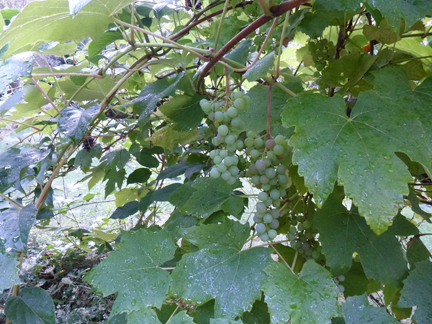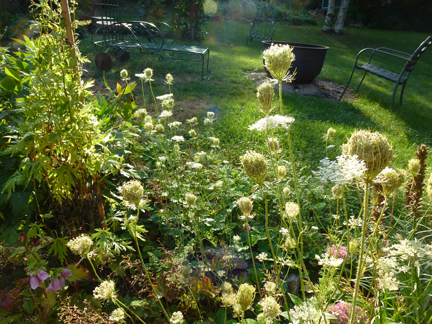The plants in my garden flower abundantly in the Spring and Summer, going from the dreamy mauve and pink of lupines and bleeding heart to bold orange day lilies, blazing scarlet Monarda and deep purple monkshood. Now it is Labor Day, September, and instead of bloom I have green tinged with brown, and yellowing leaves. Some I will leave all winter–the flower caps of Queen Anne’s Lace provide a frilly cup to hold a serving of light winter snow, and the globe thistle create a spiky silhouette against the white ground. But now they just accuse me of neglect. I try to recall when I last tended the garden, and acknowledge the accusation is justified.
In Spring I weed and plant and live and breathe my gardens. Green, all that green after a dark winter inspires me and I wake to tend the returning flowers, shrubs and vines. I prune and thin and transplant as needed. Then I just step back and admire from a distance. In mid-July there is a massive invasion of unwanted growth, and I spend a few hours in a frenzy of weed-pulling, moving with determination from one flowerbed to the next, filling the wheelbarrow again and again.
Then August blurs by in bike rides, boat rides, fund-raising dinners, family visits and no weeding. Today is Labor Day, and there it is once again, my September garden of green and brown. A pale Autumn Joy sedum is just starting to come into color and a late-blooming phlox adds some crisp white, but seed pods, yellowing leaves and dried flowerheads predominate. It has not always been like this for me. When I had a tiny in-town house with a picket-fence enclosing a tiny yard, I had the seasons under control. I had over-laying sheets of graph paper with neatly labeled plants, one for each season, so in spring I would know not to inadvertently plant on top of a yet to emerge platycodon or other late awakener. But 1600 square feet is a radical difference from an acre, and I have yet to master continual bloom here in Otter Creek. There is also a vegetable garden that requires attention, and so year after year I look around in September and sigh at the lack of color, while out of sight there are gaudy red tomatoes, ruby chard, glowing sunflowers, and vibrant squash blossoms.
Next year, I always say. That ten-foot run of phlox could be dug back to two, and surrounded with fall flowers. The Chelone is out of control, and a reducing it to a modest four-foot circle would leave additional area for Echinacea and rudbeckia. I sip my dark smoky tea, and really look at the weedy mess.
The overgrown patches are lush and full, tangled branches tumble under and over each other. Silver webs stretch from a flowerhead to a neighboring leaf, and the drops of dew, so many every night that the mornings sometimes seem washed by a light rain, reflect the light of the rising sun. There is sound, too. No gentle spring garden or showy summer blooms offer this. The leaves murmur, and there is a constant tip tap tap. It comes from all around, in the garden and from the trees above. A hiss and tremolo comes from the left, and I hear a sweet shimmering trill on the right.
The grapevines droop, each leaf holding a bright white spot of water on its tip. One drop falls with an audible “tupp” onto the leaf below. This leaf is then overloaded, and bends to send its drop and the newcomer to the next leaf. Many leaves are doing this, and the entire wall of vine is shimmying and sending out a chorus of “tip-tap –plop,” as the leaves, relieved of the weight of water, spring back up.
The climbing hydrangea near the grapes has a small fringe of white petals along the edge of what were massive flowerheads. A breeze shivers through the weeping cherry, and a lone petal drifts away from the hydrangea and descends to the browning grass, accompanied by the rustling applause of a yellowing trumpet vine, and the nodding encouragement of the Queen Anne’s Lace seed cups.
My gaze and ears continue to take in the weedy green again garden. Lazy for sure, but I think perhaps I will not pull out half the phlox and three-quarters of the chelone to plant a patch of September bloomers, after all.




